Chrysocolaptes
Chrysocolaptes is a genus of birds in the woodpecker family Picidae that are found in South and Southeast Asia.
| Chrysocolaptes | |
|---|---|
_in_Hyderabad_W_IMG_7547.jpg.webp) | |
| White-naped woodpecker (Chrysocolaptes festivus) | |
| Scientific classification | |
| Domain: | Eukaryota |
| Kingdom: | Animalia |
| Phylum: | Chordata |
| Clade: | Dinosauria |
| Class: | Aves |
| Order: | Piciformes |
| Family: | Picidae |
| Tribe: | Campephilini |
| Genus: | Chrysocolaptes Blyth, 1843 |
| Type species | |
| Picus strictus[1] Horsfield, 1821 | |
| Species | |
|
see text | |
The genus was introduced by English zoologist Edward Blyth in 1843.[2] The type species was subsequently designated as the Javan flameback (Chrysocolaptes strictus) by Scottish ornithologist Edward Hargitt in 1890.[3] The genus name combines the Ancient Greek khrusos meaning "gold" and kolaptēs meaning "chiseller".[4] The genus belongs to the tribe Campephilini in the subfamily Picinae and is sister to the orange-backed woodpecker, the only species in the genus Reinwardtipicus.[5]
Species
The genus contains these nine species:[6]
| Image | Scientific name | Common name | Distribution |
|---|---|---|---|
_in_Hyderabad_W_IMG_7547.jpg.webp) | Chrysocolaptes festivus | White-naped woodpecker | India |
.jpg.webp) | Chrysocolaptes guttacristatus | Greater flameback | Himalayas, ne India to Southern China, the Malay Peninsula, Sumatra, western and central Java, and northeast Borneo |
 | Chrysocolaptes socialis | Malabar flameback | Southwest India |
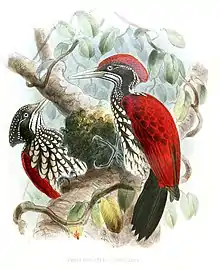 | Chrysocolaptes stricklandi | Crimson-backed flameback | Sri Lanka |
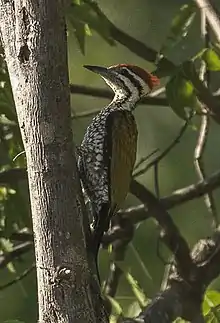 | Chrysocolaptes strictus | Javan flameback | Java, Bali, and Kangean Islands |
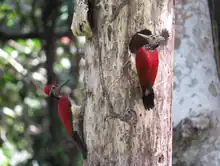 | Chrysocolaptes haematribon | Luzon flameback | Luzon, Polillo, Catanduanes, and Marinduque, the Philippines |
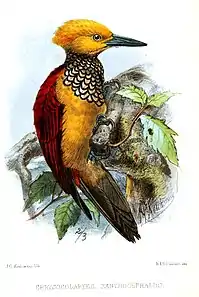 |
Chrysocolaptes xanthocephalus | Yellow-faced flameback | Philippine islands of Negros, Guimaras, Panay, Masbate, and Ticao |
.jpg.webp) | Chrysocolaptes lucidus | Buff-spotted flameback | Philippine islands of Bohol, Leyte, Samar, Biliran, Panaon, Mindanao, Basilan, and Samal |
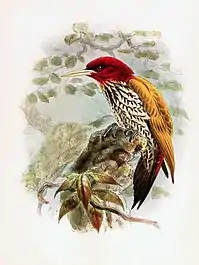 |
Chrysocolaptes erythrocephalus | Red-headed flameback | Philippine islands of Balabac, Palawan, Busuanga, and Calamian |
References
- "Picidae". aviansystematics.org. The Trust for Avian Systematics. Retrieved 2023-07-26.
- Blyth, Edward (1843). "Mr Blyth's monthly report for the December meeting, 1842, with addenda subsequently appended". Journal of the Asiatic Society of Bengal. 12 Part 2 (143): 925–1011 [1004].
- Hargitt, Edward (1890). Catalogue of the Birds in the British Museum. Vol. 18: Scansores. London: British Museum. p. 442.
- Jobling, James A. (2010). The Helm Dictionary of Scientific Bird Names. London: Christopher Helm. p. 105. ISBN 978-1-4081-2501-4.
- Shakya, S.B.; Fuchs, J.; Pons, J.M.; Sheldon, F.H. (2017). "Tapping the woodpecker tree for evolutionary insight". Molecular Phylogenetics and Evolution. 116: 182–191. doi:10.1016/j.ympev.2017.09.005. PMID 28890006.
- Gill, Frank; Donsker, David, eds. (2019). "Woodpeckers". World Bird List Version 9.2. International Ornithologists' Union. Retrieved 11 August 2019.
This article is issued from Wikipedia. The text is licensed under Creative Commons - Attribution - Sharealike. Additional terms may apply for the media files.